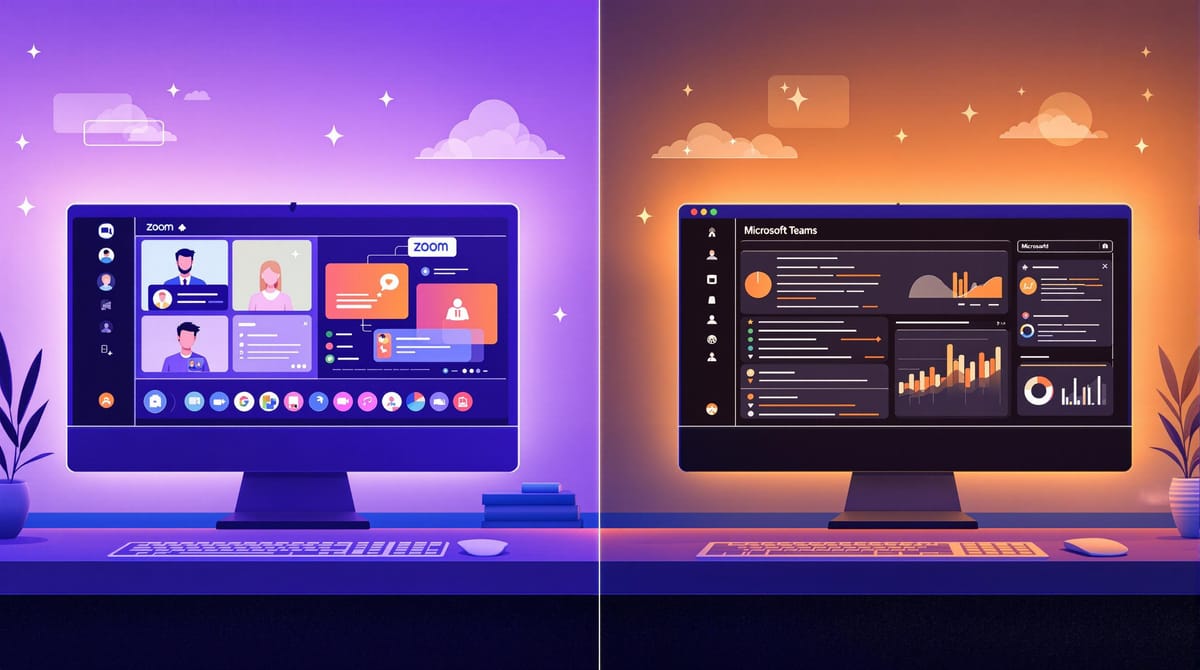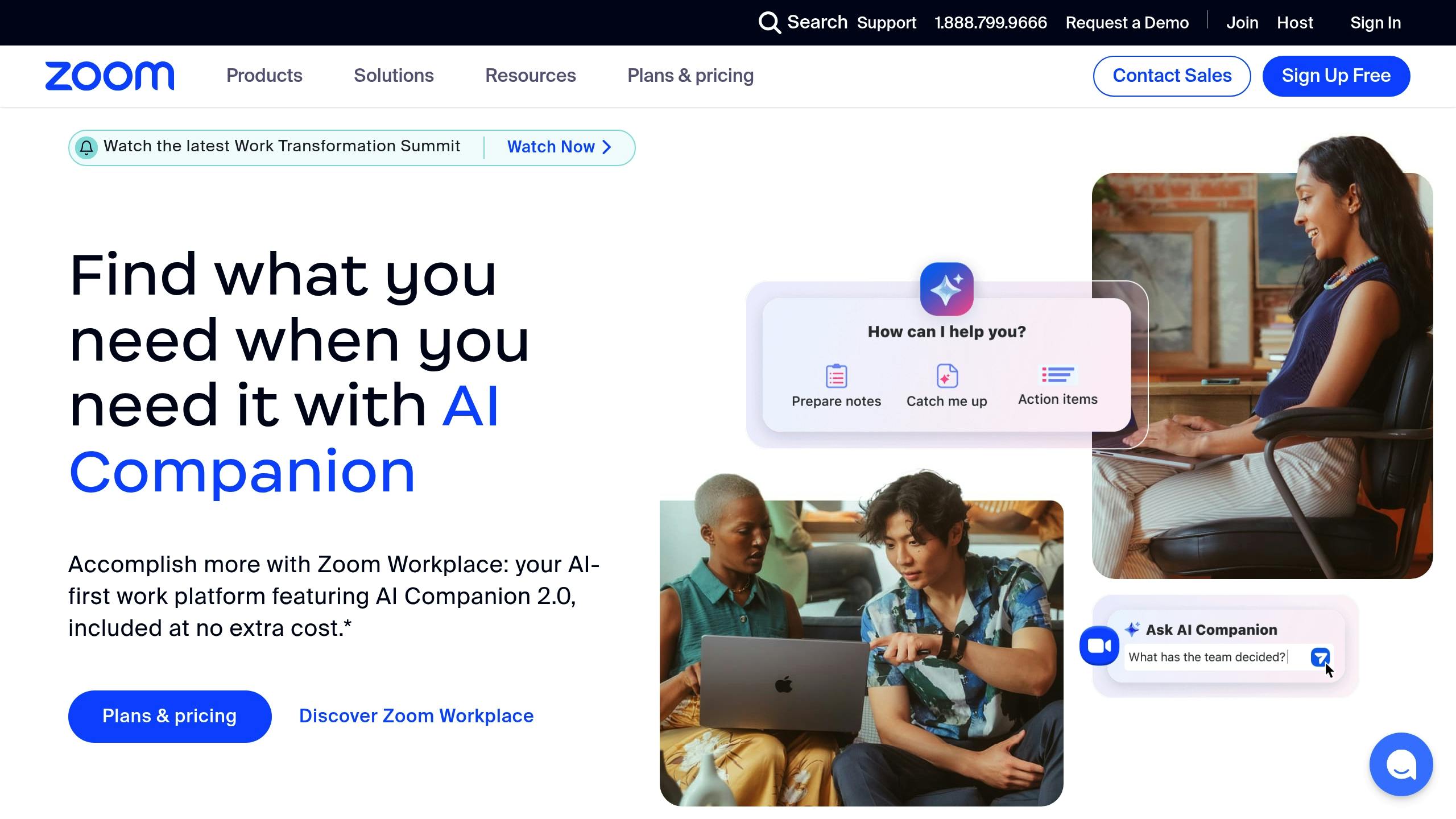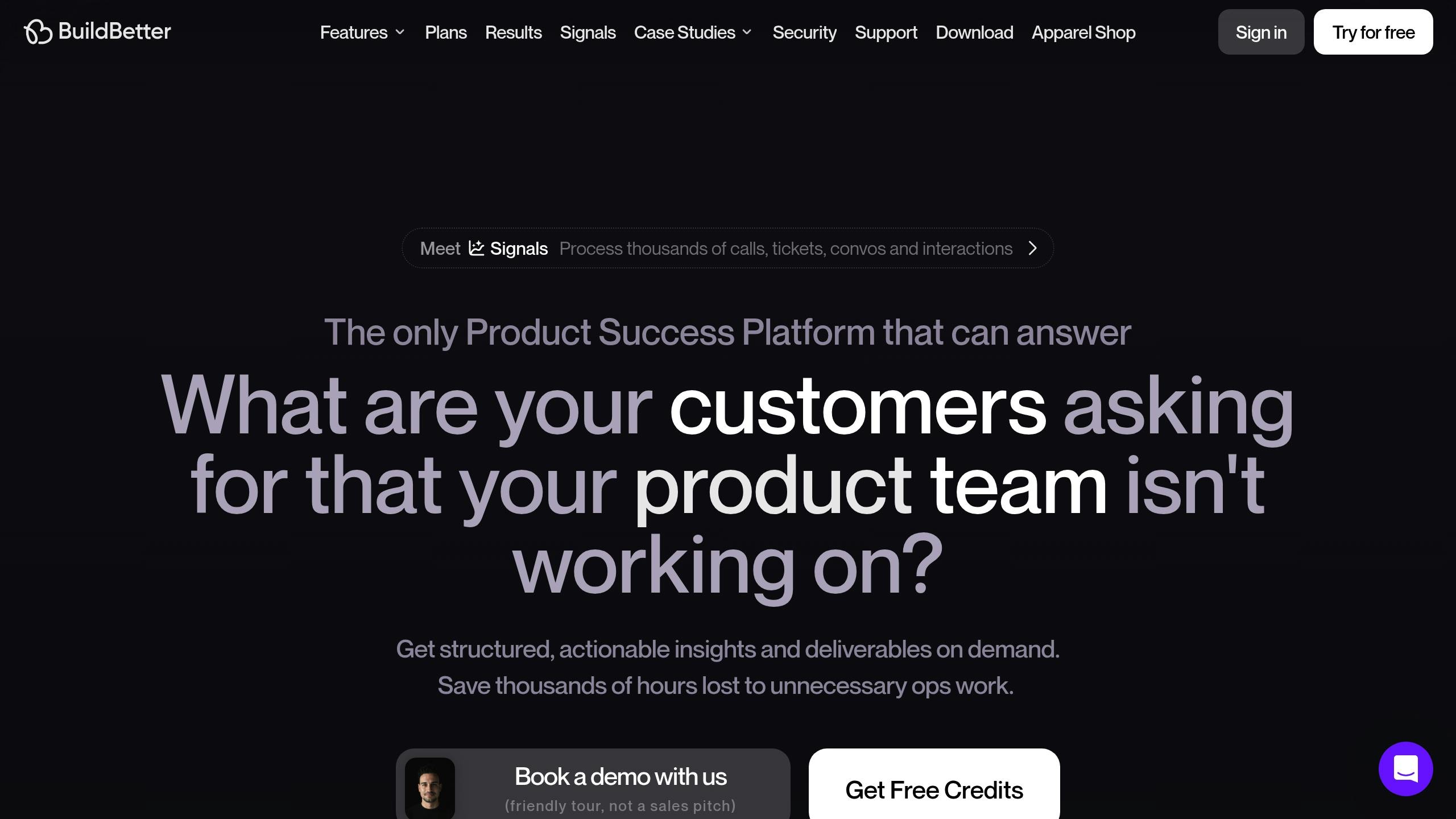Zoom vs. Teams: Best Practices for Call Recording Analysis
Explore the strengths and weaknesses of leading call recording platforms, focusing on analysis capabilities, transcription accuracy, and integration options.

AI-powered call recording tools like Zoom and Microsoft Teams are transforming how businesses analyze communication. Both platforms offer advanced features, but they cater to different needs. Here's a quick breakdown to help you decide:
-
Zoom Strengths:
- Accurate transcription (89%)
- Smart Recording with automated summaries and keyword extraction
- Scales up to 1,000 participants
-
Teams Strengths:
- Supports over 100 transcription languages
- Deep integration with Microsoft 365 tools like Power BI
- Advanced security and compliance features
Quick Comparison Table
| Feature | Zoom | Microsoft Teams |
|---|---|---|
| Transcription Accuracy | 89% | 85% |
| Languages Supported | Over 30 | Over 100 |
| Meeting Capacity | Up to 1,000 participants | Up to 300 participants |
| Storage Options | 5GB to Unlimited | 1TB per user (OneDrive/SharePoint) |
| Sentiment Analysis | Real-time tone tracking | Detailed emotion scoring |
| Integration | Third-party apps | Microsoft 365 ecosystem |
| Data Security | AES 256-bit encryption | Microsoft Priva redaction |
Key Takeaways
- Choose Zoom for better transcription accuracy, larger meetings, and sales-focused analytics.
- Choose Teams if you need multi-language support, stronger compliance tools, and seamless Microsoft 365 integration.
Both platforms offer unique advantages, and tools like BuildBetter.ai can help unify analysis across them.
Zoom vs. Teams: Basic Features

Feature Comparison
Both Zoom and Microsoft Teams offer recording capabilities, but their features differ in key ways. Zoom's Smart Recording stands out with tools like automated summaries, action items, and keyword extraction . On the other hand, Teams focuses on seamless integration with the Microsoft 365 ecosystem, providing a different kind of utility.
Here’s a breakdown of their core recording features:
| Feature | Zoom | Microsoft Teams |
|---|---|---|
| Transcription Languages | Over 30 languages | Over 100 languages |
| Storage Options | 5GB (Pro), 10GB (Business), Unlimited (Enterprise) | OneDrive/SharePoint with 1TB per user |
| Retention Policy | Indefinite within storage limits | 60-day default auto-deletion |
| Built-in Analysis | Sentiment analysis, keyword extraction, speaker identification | Basic analytics, attendance reports |
| Caption Customization | Third-party integration options | Adjustable size and position |
Zoom edges out with a transcription accuracy of 89%, compared to Teams’ 85% . For teams that rely on detailed analysis, this difference can be crucial.
Meeting Limits and User Experience
When it comes to meeting capacity, Zoom offers flexibility, accommodating 100 participants on Basic plans and scaling up to 1,000 for Enterprise users . Teams, by comparison, supports up to 300 participants in standard meetings .
Zoom provides a centralized portal with features like thumbnail previews, advanced search, and direct downloads . Teams, however, integrates recordings directly into OneDrive and SharePoint, streamlining access for Microsoft users.
Recording duration is another point of difference. Teams typically caps recordings at 4 hours for most plans , while Zoom’s limits depend on available storage , making it more suitable for extended sessions.
For organizations already using Microsoft 365, Teams' integration capabilities might tip the scale. Meanwhile, Zoom’s focus on advanced analysis tools makes it appealing for teams prioritizing data insights.
These differences play a major role in shaping how teams set up their AI-driven workflows, which we’ll explore next.
Zoom vs. Microsoft Teams: The Good, The Bad, & the Ugly
AI Analysis Steps and Methods
AI analysis workflows are where the real value of recorded meetings comes to life. While basic features like transcription lay the groundwork, the way platforms process and analyze these recordings sets them apart.
Zoom AI Analysis Process
Zoom's AI Companion works with cloud-stored recordings to deliver live transcripts, detect topics, and even analyze sentiment. For Enterprise users, Zoom IQ adds sales-focused metrics to the mix.
Teams AI Analysis Process
Microsoft Teams leverages Azure Cognitive Services to analyze recordings. With Microsoft 365 Copilot, users get detailed summaries, while Power BI turns raw data into clear, actionable visual reports.
Side-by-Side Process Comparison
Here’s a quick look at how Zoom and Teams differ in their analysis workflows:
| Analysis Step | Zoom Process | Teams Process |
|---|---|---|
| Transcription | AI Companion processing | Azure AI-powered processing |
| Sentiment Analysis | Sales-focused via Zoom IQ | Azure Cognitive Services |
| Summary Generation | AI Companion insights | Copilot-generated timelines |
| Data Integration | Third-party marketplace apps | Power BI visualizations |
| Analysis Export | Custom dashboards | Power BI visualizations |
When choosing between these platforms, consider how they fit into your current tools and workflows. Teams’ integration with Power BI can help organizations make data-driven decisions, while Zoom’s custom dashboards cater to real-time coaching and feedback needs. These distinctions play a big role in shaping the impact of speech analysis, which we’ll explore next.
Speech Analysis Tools and Features
AI-powered speech analysis tools can greatly enhance how teams evaluate call recordings, offering insights beyond basic transcription.
Keyword Detection and Mood Analysis
Both Zoom and Microsoft Teams deliver advanced keyword detection, but they take different approaches. Zoom's Smart Recording allows users to create custom industry-specific vocabularies . On the other hand, Teams Premium relies on Azure Cognitive Services to automatically identify topics during conversations .
When it comes to analyzing emotions, the platforms also stand apart:
| Feature | Zoom | Microsoft Teams |
|---|---|---|
| Sentiment Detection | Tracks positive, negative, and neutral tones in real time | Provides detailed emotion scoring |
| Integration | Focused on sales metrics | Offers visualizations via Power BI |
| Custom Rules | Supports triggers tailored to industries | Includes options for workflow automation |
Microsoft Teams' use of Azure Cognitive Services delivers more detailed emotional insights by scoring specific emotions throughout a call . This level of detail can be incredibly useful for monitoring satisfaction trends over time.
Speaker Recognition Accuracy
Speaker identification is another area where the platforms show notable differences. As previously noted with transcription, Microsoft Teams leads with 95% accuracy in recognizing speakers, even in challenging environments with background noise . Zoom, while also strong, achieves 90%+ accuracy by leveraging both audio and visual cues . Teams excels in handling overlapping conversations and noisy settings, while Zoom performs well in scenarios where participants rejoin calls or switch devices mid-conversation.
Data Security and Privacy Rules
Both platforms place a strong emphasis on security, implementing a range of protections to safeguard user data. However, their methods for managing data differ in notable ways.
GDPR and Data Storage Rules
The platforms adhere to retention policies previously discussed in the Feature Comparison section. Their approaches to data management highlight differences in organizational priorities:
| Feature | Zoom | Microsoft Teams |
|---|---|---|
| Data Residency Options | Global Data Centers in 5 regions | 30+ geographic locations |
| Data Minimization Tools | Basic redaction features | Microsoft Priva redaction |
Microsoft Teams stands out with its multi-geo capabilities, allowing businesses to store recordings across more than 30 geographic locations. This is especially beneficial for global companies navigating complex regulatory landscapes .
Security Standards and Legal Discovery
Zoom employs AES 256-bit encryption for its recordings, ensuring a secure environment for stored data . Microsoft Teams, on the other hand, leverages the Microsoft 365 encryption stack, which includes BitLocker, for an added layer of protection .
Teams also excels in eDiscovery features, offering tools through the Microsoft 365 Compliance Center. These include content searches, automated sensitivity labeling, and compliance audit trails. Access control is another area where Teams takes the lead, thanks to Microsoft Priva's advanced redaction capabilities. This tool automatically identifies and removes sensitive information from recordings, minimizing the risk of accidental data exposure. Zoom, by contrast, relies on manual redaction tools, which may require more effort and oversight .
These robust security measures influence how well each platform integrates with third-party tools, a topic we'll explore in the next section.
External Tool Integration Options
Both platforms offer third-party integrations to enhance analysis capabilities, which is key for scaling AI-driven insights. However, the security protocols for these integrations may vary.
Zoom Add-on Tools
Zoom's App Marketplace features over 1,500 apps . These tools extend Zoom's AI capabilities, as highlighted in the Speech Analysis section:
| Tool | Purpose |
|---|---|
| Gong | Identifying sales patterns |
| Insight7 | Conducting bulk qualitative analysis |
| Dialpad | Measuring customer service metrics |
Teams Add-on Tools
Microsoft Teams focuses on integrations within its own ecosystem, providing tools designed to work seamlessly with its platform:
- Power Automate: Automates custom workflows to streamline processes.
- Azure Synapse Analytics: Delivers large-scale pattern recognition across thousands of calls .
BuildBetter.ai for Both Platforms

BuildBetter.ai offers a unified analysis approach for Zoom and Teams . It provides consistent metrics, making it a valuable tool for hybrid communication strategies. This aligns with the earlier discussion on maintaining uniform AI-driven metrics to support operational decisions effectively.
Conclusion: Platform Selection Guide
After reviewing features, security, and integration options, here are the key distinctions between Zoom and Microsoft Teams:
Main Differences
| Feature | Zoom | Microsoft Teams |
|---|---|---|
| AI Integration | Standard AI features | Integrated deeply with Microsoft ecosystem |
| Language Support | 21 languages | Over 100 languages |
| Meeting Scale | Up to 1,000 participants | Up to 300 participants |
Choosing the Right Platform
Decide which platform fits your needs by focusing on these priorities:
- Enterprise Integration: If your organization relies heavily on Microsoft 365, Teams is a clear fit. It offers seamless integration with Microsoft's tools, enhanced security, and advanced eDiscovery options.
- Global Teams: Teams supports a wider range of languages, making it ideal for international teams. On the other hand, Zoom excels in transcription accuracy and handling larger-scale meetings.
- Security and Compliance: Both platforms are secure, but Teams has an advantage for businesses needing strict compliance measures, thanks to its extensive data protection capabilities.
- Budget and Growth: Zoom's free tier is a great option for startups or small teams. Larger organizations may find Teams a better long-term investment due to its scalability and enterprise-focused features.
Additionally, tools like BuildBetter.ai can help streamline analysis and integration across both platforms, offering a unified view of their capabilities .
FAQs
Are Microsoft Teams recordings private?
Yes, Microsoft Teams recordings are private by default. They are stored in OneDrive or SharePoint, with access limited to meeting participants unless shared otherwise . Here's how permissions are typically structured:
| Access Level | Permissions |
|---|---|
| Participants | Automatic access |
| External Guests | Access only if shared |
| Security Features | Includes password protection |
Teams recordings benefit from Microsoft 365's compliance tools, such as eDiscovery and retention policies . Administrators can set custom retention periods and manage access through the Microsoft 365 compliance center .
When compared to Zoom, Teams automatically grants access to all meeting invitees, while Zoom requires the host to control sharing through passcodes or links . This makes Zoom's sharing approach more customizable but less automated.
Teams also incorporates AI-powered features like speaker identification and sentiment analysis, thanks to its integration with Azure Cognitive Services. These advanced tools are designed to maintain security while offering additional functionality .
Important Privacy Notes:
- Transcripts follow the same access rules as recordings .
- External access must be explicitly approved by the meeting organizer.
These privacy measures play a critical role in determining the best platform for specific organizational needs.